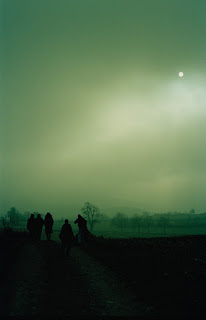
Which childhood memories do we remember? Which of these relate specifically to our Sundays spent with family?
Some will remember the pleasures, the sharing, the tenderness of exchanges, and the joy of peaceful and educational Sundays.
The day where the whole family is finally available and reunited. A child’s happiness linked to the love he receives.
Others remember these Sundays as family obligations. Dull days that never end, the heavy atmosphere, being bound by rules, and having to tolerate participating in activities imposed by the family unit. “Go and get some fresh air, it will do you good”…, “It’s been two weeks since we saw your uncle and aunt”.
Christophe Canato’s work, “A family Sunday”, reveals to us the perception of emotions and recollections procured by these family reunions.
These active sensations occur more or less in episodes. “A family Sunday. Episode 1” is a trio of images. A country landscape immersed in cold colours. The trees and the odd person are seen as black silhouettes. This glacial landscape hovers between beauty, unease and serenity.
About Christophe Canato
Since the first works in 1985, on the body, its skin, and its movement in space, it was in 1990 that Christophe Canato began photography through contemporary dance with Jean-Claude Gallotta.
This new medium becomes essential in his research. These image combinations and their associations give birth to a series of diptychs such as, "de l'image aux sens" (from the image to the senses), "trajectoire" (trajectory), “je n'ai pas dit mon dernier mot" (I have not said my last word), but equally through the more personal works such as “no man’s land”, “pièces à conviction" (incriminating evidences)…





















